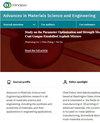制药配料的半连续混合以及工艺参数对半连续运行的集成给料混合器混合性能的影响
4区 材料科学
Q2 Engineering
引用次数: 0
摘要
制药业一直在寻找新的创新生产方式,以提高产品质量和降低工艺复杂性。在口服固体制剂产品的生产过程中,混合是确保最终产品中活性药物成分(API)均匀性的关键步骤。目前,批量混合和连续混合是业内常用的两种混合模式。然而,这些方法在混合时间、人工干预和处理多种成分的灵活性方面存在局限性。为了解决这些局限性,本研究旨在探讨在制药行业使用半连续混合模式的可行性和益处。本研究使用微晶纤维素和对乙酰氨基酚的二元混合进行了案例研究,以比较半连续混合模式与间歇和连续混合模式的性能。结果表明,半连续混合装置可生产出混合均匀度和均质性良好的混合物,其产出可用于间歇式和连续式下游操作。此外,还研究了三个最重要的工艺参数(叶轮每分钟转数、混合时间和填充量)的变化对混合均匀度的影响。半连续式混合模式的线速度为 12.5 千克/小时,高于类似规模的间歇式混合机的 3.6 千克/小时,也低于连续式混合机的线速度。新混合模式的优点包括:混合时间缩短、人工干预最少、可灵活混合多种配料、更容易扩大规模以及占地面积更小。总之,这项研究强调了在药品生产中使用这种新型半连续混合模式的相对优势,以及它作为现有混合模式良好替代品的潜力。半连续混料模式介于间歇式混料和连续式混料模式之间,与前者相比有许多优点,其性能可与后者的连续式混料模式相媲美。本文章由计算机程序翻译,如有差异,请以英文原文为准。
Semicontinuous Blending of Pharmaceutical Ingredients and the Impact of Process Parameters on the Blending Performance of an Integrated Feeder Blender Operating Semicontinuously
The pharmaceutical industry is looking for new and innovative ways of manufacturing to improve product quality and reduce process complexity. In manufacturing oral solid dosage products, blending is a crucial step in ensuring the homogeneity of active pharmaceutical ingredients (APIs) in the final product. Currently, batch and continuous blending are the two commonly used modes for blending in the industry. However, these methods have limitations in terms of blending time, manual intervention, and flexibility in handling multiple ingredients. To address these limitations, this study aims to explore the feasibility and benefits of using a semicontinuous blending mode in the pharmaceutical industry. A case study is conducted using a binary blend of microcrystalline cellulose and acetaminophen to compare the performance of the semicontinuous mode of blending with the batch and continuous blending modes. The results show that the semicontinuous blending setup can produce blends with good blend uniformity and homogeneity and that the output can be used for both batch and continuous downstream operations. The effect of variation in the three most important process parameters, impeller rotation per minute, blending time, and fill level on the blend uniformity, is also investigated. The semicontinuous blending mode had a higher line rate of 12.5 kg/hour than a similarly sized batch blender at 3.6 kg/hour and less than that of a continuous blender. The benefits of the new blending mode include reduced blending time, minimal manual intervention, flexibility in blending multiple ingredients, easier scale-up, and a smaller footprint. Overall, this study highlights the relative advantages of using this new semicontinuous blending mode in pharmaceutical manufacturing and its potential as a good alternative to the existing blending modes. The semicontinuous mode is well placed between the batch blending and continuous blending mode, with many benefits over the former mode and performance comparable to the latter continuous mode.
求助全文
通过发布文献求助,成功后即可免费获取论文全文。
去求助
来源期刊

Advances in Materials Science and Engineering
Materials Science-General Materials Science
CiteScore
3.30
自引率
0.00%
发文量
0
审稿时长
4-8 weeks
期刊介绍:
Advances in Materials Science and Engineering is a broad scope journal that publishes articles in all areas of materials science and engineering including, but not limited to:
-Chemistry and fundamental properties of matter
-Material synthesis, fabrication, manufacture, and processing
-Magnetic, electrical, thermal, and optical properties of materials
-Strength, durability, and mechanical behaviour of materials
-Consideration of materials in structural design, modelling, and engineering
-Green and renewable materials, and consideration of materials’ life cycles
-Materials in specialist applications (such as medicine, energy, aerospace, and nanotechnology)
 求助内容:
求助内容: 应助结果提醒方式:
应助结果提醒方式:


